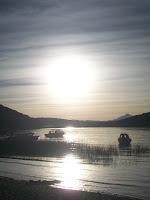Our group was a nice varied bunch, made up of a couple from Oz, another from Barcelona, a couple of comedy welsh fellas, a guy from South Korea, and a bunch of rowdy young Chilean cousins.
On the first day we travelled high up into the mountains to Abra Malaga (4316 m) where we were surrounded by the snowcapped Huacay Willca Mountains. Here we were issued our bikes, helmets and gloves, and began a two hour descent, bombing through different ecological zones at a crazy speed. I loved it! It's been a while since I've mounted my trusty stead, the majestc Raleigh Mantaray, and I've certainly never reached speeds like that before. At times it felt like 'Tour de France', the 15 of us cruising down, passing each other and various other groups along the way. The views were awsome. It made for pretty good buzz and has wet my appetite for more mountain biking. Can't beat a good bit of wholesome, carbon-free fun! As we descended the temperature rose, the insects began to sing and the sweet unmistakable scent of tropical forest became frequent. That night we stayed in the small town of Santa Maria, which felt to us a bit like Colombia, and where the local kids seem to play volleyball twenty four hours a day.
The next day was on foot. We walked for many hours, climbing narrow paths which ascended through the forest, passing the remote homes of banana growing families. It was a pretty tough day, which made the natural hot springs all the more rewarding when we got there. We stopped for the night in another tiny town, and all went out for some food and cocktails.
Next day was a 4am start, and we continued along the sacred valley of the Incas, following the beautiful Urubamba river and a disused railway track. It was a nice walk, and we reached the town of Aguas Calientes in good time, where we relaxed for the afternoon.
The next morning we started at about 3am and hiked up to the entrance of the ruins. It was pretty tough going, steep step after steep step for about 2 hours, along with the hoards of others making the same pilgramage. By the time we reached the top, there were probably eighty or so people already there, from all over the world and by the time we were allowed to enter the crowd probably swelled to about three hundred.
The 'Lost city of the Incas' were every bit as impressive as the pictures, and being there for the sunrise was nice, especially as only a fraction of the 2500 or so daily visiters were clambering around at that point.
The Incas had commenced its construction around AD 1430 as a kind of exclusive dwelling for the Inca rulers (although there are various theories about its purpose), but was abandoned a hundred years later as the Spanish pushed futher into the territory on their bloody conquest, although it turned out they had'nt even known about it anyway. Consequently they did'nt destroy it like the many other significant inca settlements they left smashed in their wake.
Most people queue for the twice daily opportunity to climb up Wayna Pichu mountain, which over looks the ruins. After hearing tails of irate tourists fighting tooth and nail to make it for the 200 places allowed, we decided to climb the less often visited Machu Picchu mountain, which stands at the oposite end of the ruins and is much higher, offering an even more spectacular view. And it was worth it. After our sweaty, heart-pounding ascent in the mid-day heat, we were rewarded with a really special view, and spent a few hours up there. To make the day even more memorable, our Australian friend proposed to his girlfriend on the way up, to the cheers of our motley crew! Luckily for us, the sun shone all day with no cloud or mist to obscure the view. All in all it was a wicked trip with a great group of people.


















































